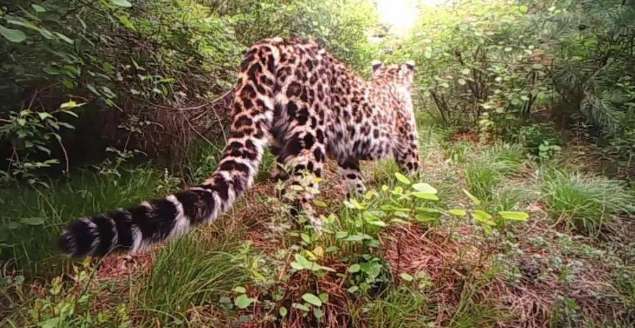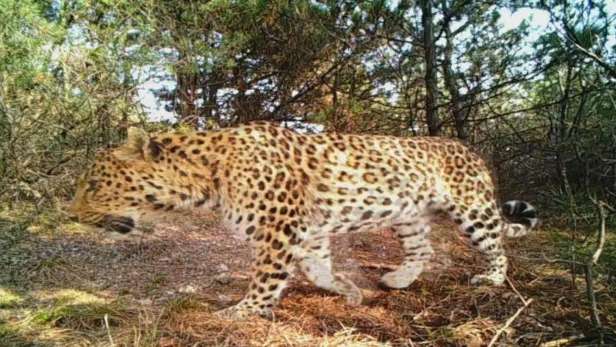Shanxi Jincheng Zezhou Macaque Nature Reserve has dense vegetation and beautiful natural scenery. In terms of ecological environment, it is relatively superior in Jincheng and even Shanxi. The mountain peaks are verdant and lush, and many rare wild animals live here.
As early as 2021, the staff of Zezhou Nature Reserve has begun to deploy infrared cameras, with more than 70 points, to monitor the living conditions and status of wild animals in the reserve. Dynamically changing trends, in recent years, a large number of real and precious images of wild animals in the wild have been captured, including many national first-level protected wild animals such as the North China leopard.

North China leopards like to hang out in mountains and hilly areas. A typical forest-dwelling animal. Recently, an infrared camera installed in Zezhou Nature Reserve detected the movements of four North China leopards. Some of them are walking in the forest, some are digging holes and digging soil to bury their feces, some are hiding in the woods with a fierce look, and some are looking for traces of prey everywhere.
Historically, the number of North China leopards in my country was quite abundant. Later, after the 1950s, due to various reasons, the number dropped sharply, and now there are less than 400 in the country. In recent years, thanks to environmental construction and animal protection, the number of North China leopards has also begun to show an upward trend.
The North China leopard hides in the Zezhou woods in Jincheng
Based on the data returned from infrared camera monitoring, experts have determined that the number of North China leopards living in the Zezhou Nature Reserve all year round may be 4 head.
Judging from the pictures, they have strong bodies and thick limbs, and are mostly adult leopards. North China leopards are large cats. Although they are second only to tigers in terms of ecological niche, as the top predator in the forest, they have very high requirements for habitat conditions just like tigers.
They require a large amount of habitat and a relatively large number of ungulate resources to meet their survival needs. The emergence of the North China leopard also means the integrity and stability of Zezhou's ecosystem and rich biodiversity.
Leopards are very adaptable large cats. They can survive in various types of environments such as grasslands, mountains, forests, and rainforests. For example, African leopards mainly live in savannas, while some leopards in Southeast Asia live in tropical rainforests.
The North China leopard is a forest-dwelling leopard. In my country, it mainly lives in forested hills or mountains. Zezhou Nature Reserve has superior ecology and lush vegetation, which is very suitable for the survival of North China leopards. NoHowever, although the environment is suitable and prey is abundant, the leopard population is still relatively slow to recover because the base is too small.
Leopards that only live in my country
Leopards in the world are divided into 9 subspecies, of which 4 are found in my country. They are: North China leopard, Northeast leopard, Indian leopard. Leopard and Indian leopard. Among these four species of leopards, only the North China leopard lives only in my country, so the North China leopard is also called the "Chinese leopard".
Their appearance is very beautiful, with khaki hair base color covered with dark markings, some of which resemble ancient copper coins, so leopards are also called "money leopards" in our country.

This is their camouflage, no matter on the grassland Even in the forest, with their fur, they can blend into the environment well, thereby increasing the success rate of hunting.
Among all leopard subspecies, North China leopards are medium in size. They have a well-proportioned body, a strong body, and thick limbs. They weigh 40-75 kilograms in adulthood, and a few larger individuals can even reach 100 kilograms.
In the past, North China leopards were widely distributed and their numbers were large. However, since the 1950s, due to heavy hunting and habitat loss, the number of North China leopards has dropped sharply, and their habitat has also been greatly reduced. Today, the North China leopard is mainly distributed in the Taihang Mountains and its extensions. The main provinces are Shanxi, Henan, and Hebei.
A survey and study based on leopard population habitats across the country shows that leopard populations across the country are showing a recovery trend, which naturally includes the North China leopard.
There is no tiger in the forest, and the leopard is the king
As we all know, the king of the forest is the tiger. In the past, our country was a big tiger country. Five of the nine subspecies of tigers in the world live in our country, ranking first in the world, and they are still very abundant. The South China tiger, in particular, is widely distributed. South China tigers are found in almost half of China's forests.
However, in the last century, South China tigers have become extinct in the wild, and the numbers of Siberian tigers, Indochinese tigers, and Bengal tigers have also become extremely rare. Therefore, most of the forests in our country currently have no tigers. . As the saying goes, "There are no tigers in the forest, but monkeys are kings." But in fact, leopards are kings.
In my country's forest ecosystem, the ecological niche of leopards is second only to tigers, and they also mainly prey on medium and large ungulates. Now that there are no tigers in the forest, leopards have naturally taken over the ecological niche of tigers and become the king of beasts in the forest.
However, compared to tigers, leopards are smaller in size, and their inhibitory effect on dealing with some large and ferocious ungulates is obviously not as good as that of tigers.
For example, in the Qinling Mountains, there lives a large ungulate called takin. When adults are strong and ferocious, even leopards have to take a detour when they see it. So even though the leopard is the "king", it is still inferior to the tiger when it comes to dealing with such animals.
The North China leopard has a strong body as an adult, with a relatively well-proportioned body and limbs. They are very ferocious, especially in the prelude to hunting. They like to hide in the woods with a fierce look in their eyes, wait for their prey to approach, then rush out quickly, knock the prey to the ground, and then choke to death.
The North China leopard is nocturnal and likes to appear at night. It mostly rests on trees or in the forest during the day. They are naturally fearful of people, but people should be careful not to get close to them when in the wild to avoid irritating leopards and triggering attacks.